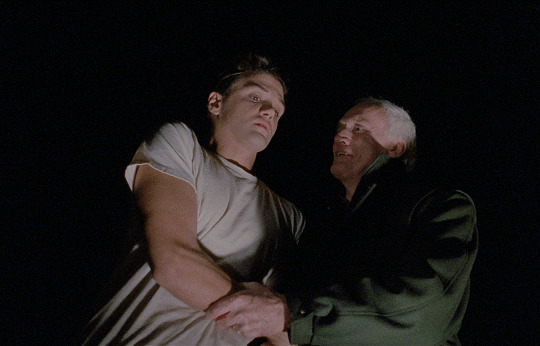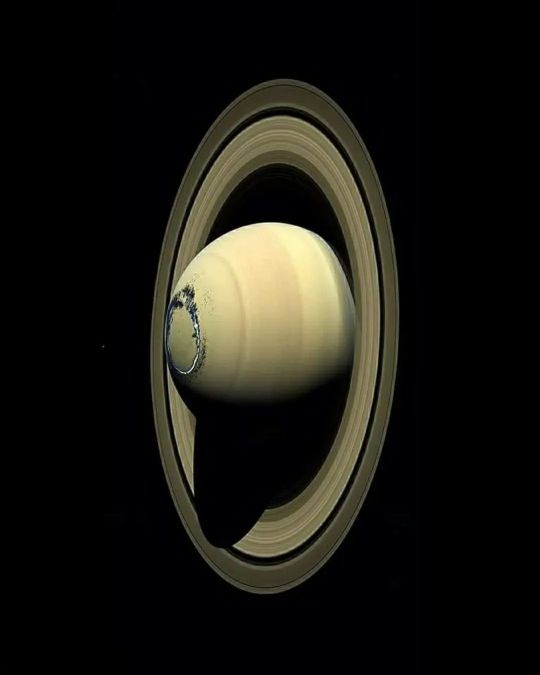#Alexander Cassini
Photo









Star Time (1992) // dir. Alexander Cassini
225 notes
·
View notes
Photo



“ The aurora on Saturn “:
like on Earth and Jupiter, are generated by the interaction between the strong and rotating magnetic field of the planet and the solar wind, the stream of particles emitted by the Sun. 🪐
The aurora on Saturn, which are only visible in ultraviolet light, pulsate and change as the underlying process varies. They form in the polar regions, high above the planet’s atmosphere where the magnetic field lines twist and the interplanetary plasma is caught in them.
Cassini flew through these clouds of plasma and the first analysis of this shows that aurora on Saturn are caused by heavier particles than on Earth. In that respect, the planet’s aurora are similar to Jupiter’s ones. That said, the team stresses that the underlying mechanism is the same among the three planets. Despite this, there are still many mysteries left to uncover. “Surprisingly many questions revolving around Saturn's auroras remain unanswered, even after the outstanding success of the Cassini mission,” lead author Alexander Bader, a graduate researcher at Lancaster University said in a statement. "This last set of close-up images gives us unique highly detailed views of the small-scale structures which couldn't be discerned in previous observations by Cassini or the Hubble Space Telescope. We have some ideas about what their origin could be, but there is still a lot of analysis to be done.
// Everything About Earth
#space#planets#earth#moon#mercury#Mars#Venus#jupiter#Saturn#Neptune#SolarSystem#galaxy#Galaxies#MilkyWay#universe#explore#follow#discover
607 notes
·
View notes
Text


A little later, I had a private audience with the Dowager Empess Marie. As the widow of the Emperor Alexander II and the mother of Emperor Nicholas II, she played an important part in Russian affairs for many years. Aunt Zoé had such family pride that she was literally obsessed by the impression her niece would make on the Empress. She kept me rehearsing in the presence of the admiring four maids and often of my uncle—how to curtsy in a proper way. “Three steps forward as you enter, then plunge, and this three times. At the end of the audience three steps backward—plunge—again three times.”
At times I'd get impatient. “Really, Aunt, I am not that much of a fool.
“You are nothing but an American monkey” she’d retort and we’d start all over. I fought a losing battle when she objected to the ensemble I had chosen—a Doucet black-and-white voile clinging gown, a large Caroline Reboux black feathered hat.
She made Josephine, the oldest maid, bring me one of her long capes and a ridiculous black bonnet.
“Wear this and you'll look as you should.”
Even Uncle protested. But she put her foot down. It was seldom that she put her foot down with him. He was always right. He was her husband, the master of her life, of her twenty thousand acres, of her herds of horses; and as she had been with her first husband so she was with her second, an obedient wife. But not this time. In this ridiculous attire I left in tears. The court carriage and its pompous coachman drove me to the Anichkoff Palace. I prayed some dreadful calamity would occur and save me from this humiliating experience. But nothing happened. I was taken through all the galleries of the Palace and through all the cold imposing official rooms, my heart throbbing with humiliation.
Then Baron Buxhoevden opened a door and I entered into the intimate library of Alexander III. The Empress stood erect under his lifesized painting. I plunged three times, three steps forward each time and waited for her to give me her hand to kiss. Even when she called me “dear child” and pinned the First Class Order of the Red Cross on my shoulder I could not smile. Twenty minutes later she had questioned me on America, my life there, the freedom of American women. Then I redid in reverse my whole stint of stepping and bowing. I had luncheon with the members of the court. It was all over. Echoes of the audience soon spread around. Every smile, every distinction, was immediately reported all over town. Many forgotten callers visited my aunt. The Empress had been surprised at so much modesty, shyness, at my unfashionable attire. She had even added, “So this is the much talked about Marguerite Cassini!” Aunt Zoé was in heaven.
Marguerite Cassini "Never a dull moment''
1 note
·
View note
Text
Study: Titan’s lakes may be shaped by waves
New Post has been published on https://sunalei.org/news/study-titans-lakes-may-be-shaped-by-waves/
Study: Titan’s lakes may be shaped by waves

Titan, Saturn’s largest moon, is the only planetary body in the solar system besides our own that currently hosts active rivers, lakes, and seas. Titan’s otherworldly river systems are thought to be filled with liquid methane and ethane that flows into wide lakes and seas, some as large as the Great Lakes on Earth.
The existence of Titan’s large seas and smaller lakes was confirmed in 2007, with images taken by NASA’s Cassini spacecraft. Since then, scientists have pored over those and other images for clues to the moon’s mysterious liquid environment.
Now, MIT geologists have studied Titan’s shorelines and shown through simulations that the moon’s large seas have likely been shaped by waves. Until now, scientists have found indirect and conflicting signs of wave activity, based on remote images of Titan’s surface.
The MIT team took a different approach to investigate the presence of waves on Titan, by first modeling the ways in which a lake can erode on Earth. They then applied their modeling to Titan’s seas to determine what form of erosion could have produced the shorelines in Cassini’s images. Waves, they found, were the most likely explanation.
The researchers emphasize that their results are not definitive; to confirm that there are waves on Titan will require direct observations of wave activity on the moon’s surface.
“We can say, based on our results, that if the coastlines of Titan’s seas have eroded, waves are the most likely culprit,” says Taylor Perron, the Cecil and Ida Green Professor of Earth, Atmospheric and Planetary Sciences at MIT. “If we could stand at the edge of one of Titan’s seas, we might see waves of liquid methane and ethane lapping on the shore and crashing on the coasts during storms. And they would be capable of eroding the material that the coast is made of.”
Perron and his colleagues, including first author Rose Palermo PhD ’22, a former MIT-WHOI Joint Program graduate student and current research geologist at the U.S. Geological Survey, have published their study today in Science Advances. Their co-authors include MIT Research Scientist Jason Soderblom; former MIT postdoc Sam Birch, now an assistant professor at Brown University; Andrew Ashton at the Woods Hole Oceanographic Institution; and Alexander Hayes of Cornell University.
“Taking a different tack”
The presence of waves on Titan has been a somewhat controversial topic ever since Cassini spotted bodies of liquid on the moon’s surface.
“Some people who tried to see evidence for waves didn’t see any, and said, ‘These seas are mirror-smooth,’” Palermo says. “Others said they did see some roughness on the liquid surface but weren’t sure if waves caused it.”
Knowing whether Titan’s seas host wave activity could give scientists information about the moon’s climate, such as the strength of the winds that could whip up such waves. Wave information could also help scientists predict how the shape of Titan’s seas might evolve over time.
Rather than look for direct signs of wave-like features in images of Titan, Perron says the team had to “take a different tack, and see, just by looking at the shape of the shoreline, if we could tell what’s been eroding the coasts.”
Titan’s seas are thought to have formed as rising levels of liquid flooded a landscape crisscrossed by river valleys. The researchers zeroed in on three scenarios for what could have happened next: no coastal erosion; erosion driven by waves; and “uniform erosion,” driven either by “dissolution,” in which liquid passively dissolves a coast’s material, or a mechanism in which the coast gradually sloughs off under its own weight.
The researchers simulated how various shoreline shapes would evolve under each of the three scenarios. To simulate wave-driven erosion, they took into account a variable known as “fetch,” which describes the physical distance from one point on a shoreline to the opposite side of a lake or sea.
“Wave erosion is driven by the height and angle of the wave,” Palermo explains. “We used fetch to approximate wave height because the bigger the fetch, the longer the distance over which wind can blow and waves can grow.”
To test how shoreline shapes would differ between the three scenarios, the researchers started with a simulated sea with flooded river valleys around its edges. For wave-driven erosion, they calculated the fetch distance from every single point along the shoreline to every other point, and converted these distances to wave heights. Then, they ran their simulation to see how waves would erode the starting shoreline over time. They compared this to how the same shoreline would evolve under erosion driven by uniform erosion. The team repeated this comparative modeling for hundreds of different starting shoreline shapes.
They found that the end shapes were very different depending on the underlying mechanism. Most notably, uniform erosion produced inflated shorelines that widened evenly all around, even in the flooded river valleys, whereas wave erosion mainly smoothed the parts of the shorelines exposed to long fetch distances, leaving the flooded valleys narrow and rough.
“We had the same starting shorelines, and we saw that you get a really different final shape under uniform erosion versus wave erosion,” Perron says. “They all kind of look like the Flying Spaghetti Monster because of the flooded river valleys, but the two types of erosion produce very different endpoints.”
The team checked their results by comparing their simulations to actual lakes on Earth. They found the same difference in shape between Earth lakes known to have been eroded by waves and lakes affected by uniform erosion, such as dissolving limestone.
A shore’s shape
Their modeling revealed clear, characteristic shoreline shapes, depending on the mechanism by which they evolved. The team then wondered: Where would Titan’s shorelines fit, within these characteristic shapes?
In particular, they focused on four of Titan’s largest, most well-mapped seas: Kraken Mare, which is comparable in size to the Caspian Sea; Ligeia Mare, which is larger than Lake Superior; Punga Mare, which is longer than Lake Victoria; and Ontario Lacus, which is about 20 percent the size of its terrestrial namesake.
The team mapped the shorelines of each Titan sea using Cassini’s radar images, and then applied their modeling to each of the sea’s shorelines to see which erosion mechanism best explained their shape. They found that all four seas fit solidly in the wave-driven erosion model, meaning that waves produced shorelines that most closely resembled Titan’s four seas.
“We found that if the coastlines have eroded, their shapes are more consistent with erosion by waves than by uniform erosion or no erosion at all,” Perron says.
Juan Felipe Paniagua-Arroyave, associate professor in the School of Applied Sciences and Engineering at EAFIT University in Colombia, says the team’s results are “unlocking new avenues of understanding.”
“Waves are ubiquitous on Earth’s oceans. If Titan has waves, they would likely dominate the surface of lakes,” says Paniagua-Arroyave, who was not involved in the study. ”It would be fascinating to see how Titan’s winds create waves, not of water, but of exotic liquid hydrocarbons.”The researchers are working to determine how strong Titan’s winds must be in order to stir up waves that could repeatedly chip away at the coasts. They also hope to decipher, from the shape of Titan’s shorelines, from which directions the wind is predominantly blowing.
“Titan presents this case of a completely untouched system,” Palermo says. “It could help us learn more fundamental things about how coasts erode without the influence of people, and maybe that can help us better manage our coastlines on Earth in the future.”
This work was supported, in part, by NASA, the National Science Foundation, the U.S. Geological Survey, and the Heising-Simons Foundation.
0 notes
Link
Check out this listing I just added to my Poshmark closet: Vintage Oleg Cassini Mermaid Sequin Blouse.
0 notes
Photo

Star Time | Alexander Cassini | 1992
66 notes
·
View notes
Photo










Star Time (1992)
#this was great#star time#alexander cassini#michael st. gerard#maureen teefy#john p. ryan#horror#slasher#90s horror#90s slasher#arthouse#arthouse horror#arthouse slasher#vinegar syndrome#underrated#masked killer#final girl#90s style#90s fashion#cinematography#obscure horror movies
378 notes
·
View notes
Photo










Star Time (1992)
40 notes
·
View notes
Photo





Louis studies astronomy
Versailles S1E9 (2015)
#versailles#derek hutchinson#alexander vlahos#george blagden#giovanni cassini#monsieur philippe#louis XIV#louis x philippe#their faces#i think he was thinking exactly the same#i love how louis reacts to philippe's jokes#this is brilliant#le roi soleil#the sun king#own gif#own post
33 notes
·
View notes
Photo




Star Time (1992) // dir. Alexander Cassini
137 notes
·
View notes
Text
2022 Leo Award Nominations - Part 1

Some Hallmark Movies and Hallstars have been nominated for for the Leo Awards. Part one of a two part post. Part one will cover the television movies.
Night One will air Tuesday, July 5 and will be live-streamed on YouTube. The pre-show will start at 6:45 and the show will start at 7pm.
The categories with nominated Hallmark movies/actors will be:
TELEVISION MOVIE
Picture Editing
Musical Score
Production Design
Costume Design
Hairstyling
Casting
Choreography
Night Three will air Saturday, July 9, hosted live at the Hyatt Regency Hotel. The show begins at 7pm.
The categories with nominated Hallmark movies/actors will be:
TELEVISION MOVIE
Program
Direction
Screenwriting
Cinematography
Supporting Performance - Male
Supporting Performance - Female
Lead Performance - Male
Lead Performance - Female

Best Television Movie
A Clüsterfünke Christmas - Producers: Jamie Goehring, Shawn Williamson, Jonathan Shore, Danielle von Zehneck, Rachel Dratch, Ana Gasteyer, Meghan Hooper White, Josh Van Houdt
A Dickens of a Holiday! - Producers: Ben C. Silverman, Shel Piercy, Cynthia Chapman
Playing Cupid - Producers: Ben C. Silverman, Shel Piercy
Right In Front of Me - Producers: Charles Cooper, John Cassini, Michael Prupas, Joel S. Rice
Secrets of a Marine’s Wife - Producers: Charles Cooper, Judith Verno
The Christmas House 2: Deck Those Halls - Producers: Charles Cooper, Ryan M. Murphy

Best Direction Television Movie
Brazen - Monika Mitchell
Kite Festival of Love (High Flying Love) - Christie Will Wolf
Playing Cupid - David Weaver
Right In Front of Me - Linda-Lisa Hayter
Signed, Sealed, Delivered: The Vows We Have Made - Linda-Lisa Hayter
Sweet Carolina - Peter Benson

Best Screenwriting Television Movie
As Gouda as it Gets - James Phillips
Kite Festival of Love (High Flying Love) - Christie Will Wolf
Best Cinematography Television Movie
A Clüsterfünke Christmas - Graham Talbot, Nelson Talbot
Dying to Belong - Amy Belling
Honey Girls - Stirling Bancroft
Poisoned in Paradise: A Martha’s Vineyard Mystery - William McKnight
Secrets of a Marine’s Wife - Adam Sliwinski
Sweet Carolina - Geoff Wallace

Best Picture Editing Television Movie
A Dickens of a Holiday - Rob Lawrenson
Honey Girls - Charles Robichaud
Mystery 101: Killer Timing - Daniel Krieger
Secrets of a Marine’s Wife - Jon Anctil
The Baker’s Son - Luis Lam

Best Musical Score Television Movie
A Christmas Together With You - Jeff Tymoschuk
A Clüsterfünke Christmas - Hal Becket
Playing Cupid - Michael Neilson
Secret life of a Student - Cameron Catalano
Soccer Mom Madam - Hamish Thomson
Best Production Design Television Movie
A Clüsterfünke Christmas - Brian Davie
Honey Girls - Paul Joyal
North to Home - Gonna Scotto
Playing Cupid - Paul Joyal
Secrets of a Marine’s Wife - Moe Curtin
Best Costume Design Television Movie
A Clüsterfünke Christmas - Jessica Kalan
Honey Girls - Barbara Gregusova
Playing Cupid - Trisha Petrovich
Secrets of a Marine’s Wife - Valerie Halverson

Best Castin Television Movie
A Dickens of a Holiday! - Annalese Tilling, Errin Lally
Making Spirits Bright - Catharine Falcon, Bim Narine
North to Home - Annalese Tilling, Errin Lally
Playing Cupid - Catharine Falcon, Bim Narine

Best Supporting Performance Male Television Movie
A Clüsterfünke Christmas - Nils Hognestad
Making Spirits Bright - John Cassini
Open by Christmas - Michael Karl Richards
Robin Roberts Presents: Mahalia - Jim Thorburn
The Christmas House 2: Deck Those Halls - Brad Harder

Best Supporting Performance Female Television Movie
Brazen - Emilie Ullerup
Chasing Waterfalls - Rhinda Dent
Cradle Did Fall - Kristen Robek
Journey of My Heart - Bethany Brown
The Other Me - Pauline Egan

Best lead Performer Male Television Movie
Love on Fire - Devon Alexander
Making Spirits Bright - Carlo Marks
North to Home - Tom Stevens
Psycho Intern - Madison Intern
Right in Front of Me - Marco Grazzini
#leo awards#hallmark movies#hallmark stars#hallmark history#a dickens of a holiday#playing cupid#right in front of me#the christmas house 2: deck those halls#high flying love#signed sealed delivered: the vows we have made#sweet carolina#peter benson#poisoned in paradise: a martha's vineyard mystery#mystery 101: killer timing#the baker's son#a christmas together with you#north to home#making spirits bright#open by christmas#michael karl richards#brad harder#carlo marks#marco grazzini
3 notes
·
View notes
Text
Events 7.1
AD 69 – Tiberius Julius Alexander orders his Roman legions in Alexandria to swear allegiance to Vespasian as Emperor.
552 – Battle of Taginae: Byzantine forces under Narses defeat the Ostrogoths in Italy, and the Ostrogoth king, Totila, is mortally wounded.
1097 – Battle of Dorylaeum: Crusaders led by prince Bohemond of Taranto defeat a Seljuk army led by sultan Kilij Arslan I.
1431 – The Battle of La Higueruela takes place in Granada, leading to a modest advance of the Kingdom of Castile during the Reconquista.
1520 – Spanish conquistadors led by Hernán Cortés fight their way out of Tenochtitlan after nightfall.
1523 – Jan van Essen and Hendrik Vos become the first Lutheran martyrs, burned at the stake by Roman Catholic authorities in Brussels.
1569 – Union of Lublin: The Kingdom of Poland and the Grand Duchy of Lithuania confirm a real union; the united country is called the Polish–Lithuanian Commonwealth or the Republic of Both Nations.
1643 – First meeting of the Westminster Assembly, a council of theologians ("divines") and members of the Parliament of England appointed to restructure the Church of England, at Westminster Abbey in London.
1690 – Glorious Revolution: Battle of the Boyne in Ireland (as reckoned under the Julian calendar).
1766 – François-Jean de la Barre, a young French nobleman, is tortured and beheaded before his body is burnt on a pyre along with a copy of Voltaire's Dictionnaire philosophique nailed to his torso for the crime of not saluting a Roman Catholic religious procession in Abbeville, France.
1770 – Lexell's Comet is seen closer to the Earth than any other comet in recorded history, approaching to a distance of 0.0146 astronomical units (2,180,000 km; 1,360,000 mi).
1782 – Raid on Lunenburg: American privateers attack the British settlement of Lunenburg, Nova Scotia.
1819 – Johann Georg Tralles discovers the Great Comet of 1819, (C/1819 N1). It was the first comet analyzed using polarimetry, by François Arago.
1837 – A system of civil registration of births, marriages and deaths is established in England and Wales.
1846 - Adolphe Sax patents the saxophone.
1855 – Signing of the Quinault Treaty: The Quinault and the Quileute cede their land to the United States.
1858 – Joint reading of Charles Darwin and Alfred Russel Wallace's papers on evolution to the Linnean Society of London.
1862 – The Russian State Library is founded as the Library of the Moscow Public Museum.
1862 – Princess Alice of the United Kingdom, second daughter of Queen Victoria, marries Prince Louis of Hesse, the future Louis IV, Grand Duke of Hesse.
1862 – American Civil War: The Battle of Malvern Hill takes place. It is the last of the Seven Days Battles, part of George B. McClellan's Peninsula Campaign.
1863 – Keti Koti (Emancipation Day) in Suriname, marking the abolition of slavery by the Netherlands.
1863 – American Civil War: The Battle of Gettysburg begins.
1867 – The British North America Act takes effect as the Province of Canada, New Brunswick, and Nova Scotia join into confederation to create the modern nation of Canada. Sir John A. Macdonald is sworn in as the first Prime Minister of Canada. This date is commemorated annually in Canada as Canada Day, a national holiday.
1870 – The United States Department of Justice formally comes into existence.
1873 – Prince Edward Island joins into Canadian Confederation.
1874 – The Sholes and Glidden typewriter, the first commercially successful typewriter, goes on sale.
1878 – Canada joins the Universal Postal Union.
1879 – Charles Taze Russell publishes the first edition of the religious magazine The Watchtower.
1881 – The world's first international telephone call is made between St. Stephen, New Brunswick, Canada, and Calais, Maine, United States.
1881 – General Order 70, the culmination of the Cardwell and Childers reforms of the British Army, comes into effect.
1885 – The United States terminates reciprocity and fishery agreement with Canada.
1885 – The Congo Free State is established by King Leopold II of Belgium.
1890 – Canada and Bermuda are linked by telegraph cable.
1898 – Spanish–American War: The Battle of San Juan Hill is fought in Santiago de Cuba, Cuba.
1901 – French government enacts its anti-clerical legislation Law of Association prohibiting the formation of new monastic orders without governmental approval.
1903 – Start of first Tour de France bicycle race.
1908 – SOS is adopted as the international distress signal.
1911 – Germany despatches the gunship SMS Panther to Morocco, sparking the Agadir Crisis.
1915 – Leutnant Kurt Wintgens of the then-named German Deutsches Heer's Fliegertruppe army air service achieves the first known aerial victory with a synchronized machine-gun armed fighter plane, the Fokker M.5K/MG Eindecker.
1916 – World War I: First day on the Somme: On the first day of the Battle of the Somme 19,000 soldiers of the British Army are killed and 40,000 wounded.
1922 – The Great Railroad Strike of 1922 begins in the United States.
1923 – The Parliament of Canada suspends all Chinese immigration.
1931 – United Airlines begins service (as Boeing Air Transport).
1931 – Wiley Post and Harold Gatty become the first people to circumnavigate the globe in a single-engined monoplane aircraft.
1932 – Australia's national broadcaster, the Australian Broadcasting Corporation, was formed.
1935 – Regina, Saskatchewan police and Royal Canadian Mounted Police ambush strikers participating in the On-to-Ottawa Trek.
1942 – World War II: First Battle of El Alamein.
1942 – The Australian Federal Government becomes the sole collector of income tax in Australia as State Income Tax is abolished.
1943 – The City of Tokyo and the Prefecture of Tokyo are both replaced by the Tokyo Metropolis.
1946 – Crossroads Able is the first postwar nuclear weapon test.
1947 – The Philippine Air Force is established.
1948 – Muhammad Ali Jinnah (Quaid-i-Azam) inaugurates Pakistan's central bank, the State Bank of Pakistan.
1949 – The merger of two princely states of India, Cochin and Travancore, into the state of Thiru-Kochi (later re-organized as Kerala) in the Indian Union ends more than 1,000 years of princely rule by the Cochin royal family.
1957 – The International Geophysical Year begins.
1958 – The Canadian Broadcasting Corporation links television broadcasting across Canada via microwave.
1958 – Flooding of Canada's Saint Lawrence Seaway begins.
1959 – Specific values for the international yard, avoirdupois pound and derived units (e.g. inch, mile and ounce) are adopted after agreement between the US, the United Kingdom and other Commonwealth countries.
1960 – The Trust Territory of Somaliland (the former Italian Somaliland) gains its independence from Italy. Concurrently, it unites as scheduled with the five-day-old State of Somaliland (the former British Somaliland) to form the Somali Republic.
1960 – Ghana becomes a republic and Kwame Nkrumah becomes its first President as Queen Elizabeth II ceases to be its head of state.
1962 – Independence of Rwanda and Burundi.
1963 – ZIP codes are introduced for United States mail.
1963 – The British Government admits that former diplomat Kim Philby had worked as a Soviet agent.
1966 – The first color television transmission in Canada takes place from Toronto.
1967 – Merger Treaty: The European Community is formally created out of a merger with the Common Market, the European Coal and Steel Community, and the European Atomic Energy Commission.
1968 – The United States Central Intelligence Agency's Phoenix Program is officially established.
1968 – The Treaty on the Non-Proliferation of Nuclear Weapons is signed in Washington, D.C., London and Moscow by sixty-two countries.
1968 – Formal separation of the United Auto Workers from the AFL–CIO in the United States.
1972 – The first Gay pride march in England takes place.
1976 – Portugal grants autonomy to Madeira.
1978 – The Northern Territory in Australia is granted self-government.
1979 – Sony introduces the Walkman.
1980 – "O Canada" officially becomes the national anthem of Canada.
1983 – A North Korean Ilyushin Il-62M jet en route to Conakry Airport in Guinea crashes into the Fouta Djallon mountains in Guinea-Bissau, killing all 23 people on board.
1984 – The PG-13 rating is introduced by the MPAA.
1987 – The American radio station WFAN in New York City is launched as the world's first all-sports radio station.
1990 – German reunification: East Germany accepts the Deutsche Mark as its currency, thus uniting the economies of East and West Germany.
1991 – Cold War: The Warsaw Pact is officially dissolved at a meeting in Prague.
1997 – China resumes sovereignty over the city-state of Hong Kong, ending 156 years of British colonial rule. The handover ceremony is attended by British Prime Minister Tony Blair, Charles, Prince of Wales, Chinese President Jiang Zemin, and U.S. Secretary of State Madeleine Albright.
1999 – The Scottish Parliament is officially opened by Elizabeth II on the day that legislative powers are officially transferred from the old Scottish Office in London to the new devolved Scottish Executive in Edinburgh. In Wales, the powers of the Welsh Secretary are transferred to the National Assembly.
2002 – The International Criminal Court is established to prosecute individuals for genocide, crimes against humanity, war crimes, and the crime of aggression.
2002 – Bashkirian Airlines Flight 2937, a Tupolev Tu-154, and DHL Flight 611, a Boeing 757, collide in mid-air over Überlingen, southern Germany, killing all 71 on board both planes.
2003 – Over 500,000 people protest against efforts to pass anti-sedition legislation in Hong Kong.
2004 – Saturn orbit insertion of Cassini–Huygens begins at 01:12 UTC and ends at 02:48 UTC.
2006 – The first operation of Qinghai–Tibet Railway is conducted in China.
2007 – Smoking in England is banned in all public indoor spaces.
2008 – Riots erupt in Mongolia in response to allegations of fraud surrounding the 2008 legislative elections.
2013 – Croatia becomes the 28th member of the European Union.
2020 – The United States–Mexico–Canada Agreement replaces NAFTA.
1 note
·
View note
Photo

Fur Real. by vintagedollrisa featuring Etienne Aigner
#polyvore#fashion#style#E L L E R Y#T By Alexander Wang#Topshop#Chanel#Oleg Cassini#Etienne Aigner#Estée Lauder#clothing
4 notes
·
View notes
Text
20 years of blogging at Boing Boing

Twenty years ago today, Boing Boing became a blog. Mark Frauenfelder's first post linked to Street Tech, a now-dormant gadget blog. Now there are 160,000 more posts just like it and the impossible task of summarizing the best of them in yet another.
Founded as a print zine in 1988 by Mark and Carla Sinclair, Mark's personal retrospective posted earlier today is a must-read; following are a few of our greatest hits, proudest accomplishments, clickiest traffic monsters, and best features of all time.
Despite the tens of millions of words in our database – mostly wonderful things – it's oftentimes the shortest posts that get the most attention.
So it was with Xeni Jardin's Ralph Lauren opens new outlet store in the Uncanny Valley, a single-sentence reblog of a now-vanished post at another site highlighting the incompetently dysmorphic photomanipulations in one of the fashion house's ads.
Ralph Lauren tried to force us to remove the post, to no avail.
That wasn't our first rodeo, either. In 2008, were were sued by MagicJack, makers of a VoIP dongle, after criticizing its terms of service. We stood our ground and beat them in court. Ten years later, Playboy sued us for posting about someone else's uploaded cover collection, claiming that linking to things is a form of copyright infringement. We beat them too, with the help of able friends at the Electronic Frontier Foundation.
It's not all law and chaos, though.
Mark Frauenfelder says he's most proud of his two-part series on the fortified residential mailboxes of Los Angeles, Survival of the fittest mailbox and Fortified mailboxes, part 2. Readers, though, say his greatest gift to the world of letters is the gentlemen of Boing Boing.
A trilogy of Cory Doctorow's most incisive writing on technology, policy and freedom is found in Lockdown, based on his keynote speech to the Chaos Computer Congress in 2011, The Coming Civil War over General Purpose Computing, and Anodyne Anonymity. Also, would you just look at that banana. Furthermore, Christ, what an asshole.
David Pescovitz is a collector of unpopular culture with an affinity for haunted ontology, mall nostalgia and cryptids (more!, with a Grammy on the shelf for his part in reissuing the Voyager Golden Record.
But it's his touching obituary for Mark, his older brother, that will not be forgotten.
Xeni Jardin's posted countless articles about cutting-edge tech and light-hearted nods to the wonders of the web, and more seriously about politics, but it's her writing about cancer, hers and others', that sticks with readers. The Diagnosis; When life hands you cancer, make cancer-ade; Obamacare saved my life; Cancer and cannabis: How I learned to stop worrying and love medical marijuana; A medal for completing breast cancer treatment; and We should be worried that science has not yet brought us closer to understanding cancer.
Rob Beschizza's The Weird of Wendy Pini profiles one of America's most successful women cartoonists. His random generators include the Psygnosis Game Generator, the North Korean Press Release Generator and the Audiophile Hardware Review Generator. (For those who don't revile them, Rob's disturbing mouth-eyed politician shoops are collected in the gallery item Corinthian Leather). Fissure opens in Chess AI scene is a deep dive into a code-plagiarism scandal. He once reviewed a loaf of snot.
He eulogized his mother, Mandy Johnson, in 2016.
Did you know Boing Boing publisher Jason Weisberger was namechecked in a saucy romance novel?
Jason has also written obituaries for his close friends Molly, Lucy, Calliope and Nemo.
We published critical games writing under the aegis of Offworld, edited by Leigh Alexander: All the women I know in video games are tired and Why Silent Hill mattered. Zoë Quinn's call to creative arms, Punk Games, remains as relevant now as it was five years ago.
Laura Hudson's Women take a place at the pinball table is a deep look at a unique competetive area, complemented by her excellent reviews of games as different as Undertale — choose to kill monsters or understand them
— and Bloodborne — In Bloodborne's brutal world, I found myself.
Our longtime science editor Maggie Koerth-Baker's analysis of the Fukushima Daiichi nuclear disaster was featured in the anthology The Best Science Writing Online 2012. Don't miss her profile of James Watson, either.
Though known for chaingun blogging, we pioneered the trend toward Fancy Lookin' Features on the web, such as Maggie's Cassini Trip Reset, highlighting the astonishing imagery from NASA's probe, and Rob Beschizza's Friendly Darkness in the Palace of Utopian Fantasy, linking rare threads of modern and Victorian fantasy.
Here's just a few more of the nice features we've published over the years:
1906: Vintage Photographs by Mike Shaughnessy
Leaking Secrets, leaking Blood by Raul Gutierrez
Death in Space, by Maggie Koerth-Baker
Ghost Babies, by Mark Dery
A Season in Hell, by Mark Dery
Hajj for Heathens, by Omar Chatriwala
Maps, by Simon Parkin
Other guests are too many to mention – there are more than five hundred contributors in our archives now – but they account for many of our finest posts. Among the best are Sawyer Rosenstein's Don't tell me the sky is the limit when there are footprints on the moon and the many annual iterations of David Ng and Ben Cohen's Halloween Candy Hierarchy.
Glenn Fleishman's Domo Arigato, Mr. Roboto is typeset in the then-new Google typeface it was about, and What it's like to be on Jeopardy is about his brief but impressive stint on the game show.
Unseen World War I photos: German Trenches reveals a unique collection of photographs inherited by Dean Putney, our longtime developer, from his great-grandfather Walter Koessler.
Carl Malamud is well-known for Liberating America's secret, for-pay laws, and we're immensely proud to have helped him make his stand.
We've also published loads of fiction over the years, including our own, such as Cory's By His Things Will You Know Him and The Man Who Sold The Moon, Jason's Kevin's List, and Rob's Mixtape of the Lost Decade, Such Bravery and Nomen Ludi.
Finally, here are our top traffic posts since we started counting: a master key for winning at blogging. But only if you have a time machine, because the web, as they say, is dead.
1. Nigerian astronaut lost in space
2. Rickrolling is sexist, racist and often transphobic in context
3. 'To Donald Trump,' by Leland Melvin, former NASA Astronaut and NFL Player
4. 16-year-old girl who took nude selfie photos faces adult sex charges
5. Campus rapist given lenient sentence to avoid "severe impact on him"
6. Man stole $122m from Facebook and Google by sending them random bills, which the companies dutifully paid
7. Climate change denier Rupert Murdoch just bought National Geographic, which gives grants to scientists
8. Trump is angry at NBC News for using this photo of him, so please don't use this enhanced, enlarged version of it for anything
9. I'm married. I'm a woman. I'm addicted to porn.
10. For sale: (1) California ghost town
https://boingboing.net/2020/01/21/20-years-of-blogging-at-boing.html
12 notes
·
View notes
Text
New Year party style 2018
New Year party style 2018 by foxxyslang featuring a perfume fragrance ❤ liked on Polyvore
Oleg Cassini sparkly dress
44,575 INR - 1stdibs.com
Aquazzura velvet shoes
29,295 INR - ekseption.us
Alexander McQueen leather purse
123,885 INR - alexandermcqueen.com
Marni earrings
35,275 INR - net-a-porter.com
Eyeshadow
430 INR - lovelemonade.com
Makeup
1,140 INR - nablacosmetics.com
Dolce Gabbana perfume fragrance
3,820 INR - douglas.de
Essie nail polish
575 INR - macys.com
0 notes
Photo

Star Time | Alexander Cassini | 1992
25 notes
·
View notes